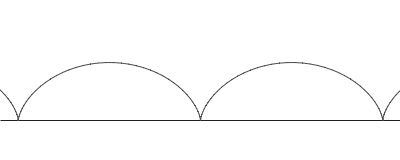What to make of End Times prophecies? - Toynbee's Wheel and Chrysalis model
 |
| The wheel of history rolls forward. (Courtesy Wikimedia Commons) |
My last post ended on a note of pessimism for the future of our society. I promised I would follow that up with a more optimistic post. … Ok, so this one isn’t pure optimism, but at least maybe it’s more balanced? I will note up front that my personal bias in favor of The Church of Jesus Christ of Latter-day Saints shows through strongly in this post – reader beware – and the ideas I express here are highly speculative.
I used to wonder what was the point of end-times revelations. The prophecies aren’t really specific enough to plan by. We are told that Christ will come “as a thief in the night,” suggesting that the end-times prophecies were never meant as a clear timeline. Revelations tell of wars, plagues, disasters, and descriptions of what sound like at least partial societal collapse, but finally the Lord will return and usher in the Millennial reign of peace and glory. The internet is filled with piles of speculation, but we don’t really know what it all means in literal specifics. So why the vague end-times guidance?
For a number of years, I have had a running joke with my wife that our civilization has peaked and we are on the downward trajectory. Whenever we come across a product or service that has suddenly become significantly worse, smaller, or less robust (which is seriously all the time these days!), I joke to my wife that this is more evidence that our civilization is in decline. I gesture with my hand the motion of creating a hill and starting to move downward past the peak. Smaller granola bars - civilization in decline! The latest Microsoft bungled productivity package - our society is way past its peak! The latest survey data shows a continued decline in church attendance - collapse of the West! It was kind of a joke, and I didn’t take it seriously, and I imagined there could be another Great Awakening or something1 to restore our values and and take us back to peak civilization (i.e. basically like my childhood heyday of the 1990s, plus iPhones).
That was before I read The Rise and Triumph of the Modern Self, by Carl R. Trueman. Trueman is very much focused on changes in what Charles Taylor calls the “social imaginary,” which overlaps Jonathan Haidt’s “moral intuition,” and Roger Scruton’s “culture.” These are the unconscious ideas, assumptions, and intuitions, passed down through time and culture, that determine how we approach and make sense of the world. The influence (for good or evil) of this sub-conscious and largely unexplored “social imaginary” should not be underestimated. Our ability to use reason to find truth is bounded by these typically unspoken ideas and beliefs.
 |
| This book may change the way you see the modern world. |
Trueman takes the reader through a historical progression of how people view human fulfillment and purpose. Back in the writings of Augustine of Hippo (354-430 AD), man’s purpose was to align our will with God’s. This conception was the core of the sacred order. That’s not to say that they were necessarily good at it or more moral than us, just that they would have considered conforming oneself to God’s will as a virtue. In more modern times, subversive thinkers altered this perception, and cultural influencers passed these new ideas from philosophy into the social imaginary over time. Rousseau essentially internalized and psychologized fulfillment (making it less about understanding God’s external will, but following one’s own internal desires). Nietzsche rejected any objective foundation for fulfillment and morality, describing values in terms of aesthetics and taste. Marx then politicized the personal and Freud sexualized human fulfillment and the meaning of selfhood. Cultural influences like Rousseau’s novels, Romantic poets, Surrealist art, pornography, etc. spread these concepts from philosophy into the social imaginary of the common man through culture, to the point that these ideas now are now taken for granted and have even become the basis for law - Supreme Court decisions, for example.2 This change in the social imaginary encompasses the Sexual Revolution, but is actually much broader - it is a change in the very idea of selfhood, or what it means to exist as a human in the world. No longer is finding God and Truth the highest ideal. Instead our society now honors no objective moral grounding, but values performative expressions of one’s unique individualism, with sexuality as the most central aspect of individuality and fulfillment.3
When I finished this book it became clear to me just how far our Western moral intuitions and values have drifted away from God and moral truth. I don’t want to put the past on a pedestal, but how can a society that doesn’t even see God as good be ruled by Christ in Millennial splendor? How do we even get from here to there? As I finished The Rise and Triumph of the Modern Self, it occurred to me seriously for the first time, in a deeply emotional and tearful moment, that the only way to bring about a Millennial future might actually be for our society as it currently exists to be destroyed in some fundamental way, so that a new society can arise from the ashes with a different and humbler moral perspective.
The idea of civilizational decline and social collapse is terrifying! We are living in a Golden Age now, but we are starting to see the fissures in our society widen, we are experiencing plagues, supply chain disruptions, great power geopolitical conflicts, and looming war. Nuclear weapons and claims of climate catastrophe hang over us. The economy and supply chain now look more fragile than we had anticipated. There is a general sense of unease permeating society. More people now think that their children will have life worse off than the present. Here's where the ancient scripture comes into play - as things go downhill, even if it means a fundamental collapse of society, the lesson of the end-times prophecies is that we don’t need to panic or despair. As wars claim more and more of our attention, we can hold fast to our principles as always before. As pandemics multiply, we don’t need to fear. God has foreseen our times and knows our conditions. Yes, things will get bad, but we can trust in Him. This is the plan, and everything is under control. I am increasingly grateful for the end times prophecies and revelations, because they allow me to stay calm and come to terms with decline.
As a side note, I now find myself oddly aligned with certain aspects of Frankfurt Schooler and architect of the New Left Herbert Marcuse’s shocking essay, An Essay on Liberation (see also my comment to an old post on 1960s marxism). I find myself in sort-of agreement (though not in the way he meant) with his assessment that the psychology and mental makeup of humanity as it currently stands is inconsistent with Utopia on Earth. Before that Millennial day, there needs to arise “a new sensibility” in man, according to Marcuse, which needs to replace the current Western psychology. Now, Marcuse’s solution was an explicit call for Marxist indoctrination, the overthrow of Christian and Western values, violence, and communism - none of which I can endorse. Instead, revealed scripture teaches us to trust in God as He works through the unfolding of history to re-make our society into the Utopia Marcuse could never deliver on.
Philosopher Eric Voegelin once wrote that the Marxists fundamental error was in trying to “immanentize the eschaton” (such a fun phrase) - hubristically attempting to bring heaven to earth through corrupt mortal means. Accordingly, my writing this post is obviously not to encourage the decline, but to suggest that we can remain hopeful and optimistic in Christ even through times of social strife that may come.
 |
| British historian Arnold J. Toynbee (1889-1975) |
The successive rises and falls of the primary and the secondary civilizations are examples of a rhythm—observed in other contexts—in which the successive revolutions of a wheel carry forward the vehicle which the wheel conveys. And, if we ask why the descending movement in the revolution of the wheel of civilization should be the means of carrying forward the chariot of Religion, we shall find the answer in the truth that Religion is a spiritual activity and that spiritual progress is subject to a ‘law’ proclaimed by Aeschylus in the two words πάθει μάθος — 'we learn by suffering'.
I don't have sufficient knowledge of Mahayana Buddhism or Islam to comment on Toynbee's non-Western claims, so I’ll focus on the West. We see monotheistic Judaism rise from among the human sacrificing pagans of antiquity. Christianity arose from Judaism and spread as the Roman Empire was decaying, and became the dominant cultural force in the West, which far exceeded all other societies in its splendor. If the cycles continue as they have, if we project Toynbee's model forward (obviously very speculative), what would we expect? Toynbee would expect to see the start of a higher religion during the time of troubles during the decline of the West. This higher religion would then survive the collapse the West to become the “chrysalis” from which a new society would emerge on an even higher plane after the West as we know it now is no more.
“The idea of the Church thus formed an invaluable fixed point round which a new civilization could slowly crystallize.” [quoting F. C. Burkitt] On this view universal churches have their raison d’être in keeping the species of society known as civilizations alive by preserving a precious germ of life through the perilous interregnum, between the dissolution of one mortal representative of the species and the genesis of another. A church would thus be part of the reproductive system of civilizations, serving as egg, grub, and chrysalis between butterfly and butterfly.
 |
| source |
In fact we have seen the beginning of a re-invigorated strain of Christianity arising from the remnant of Christendom - a church which has grown exponentially (at a similar rate of growth as early Christianity itself, according to the late sociologist Rodney Stark, in The Triumph of Christianity) and is holding its own in numbers and preserving its values even as Christian churches generally experience trying times. This is The Church of Jesus Christ of Latter-day Saints. Its founder Joseph Smith famously prophesied that the Church would survive the calamities of the last days and fill the earth in preparation for the Second Coming:
The Standard of Truth has been erected; no unhallowed hand can stop the work from progressing; persecutions may rage, mobs may combine, armies may assemble, calumny may defame, but the truth of God will go forth boldly, nobly, and independent, till it has penetrated every continent, visited every clime, swept every country, and sounded in every ear, till the purposes of God shall be accomplished, and the Great Jehovah shall say the work is done.
Even if the West continues in its moral decay and civilizational decline, a nucleus of higher religion will survive the collapse and continue growing, a chrysalis from which the eventual Millennial society can emerge, prepared to be ruled over by Christ Himself. It is worth noting that the Church and its current prophet, President Nelson, are very self-consciously taking on the role of preparing the world for the Savior's Second Coming.
There is much rhetoric in the church these days about the "ongoing" or "continuing" Restoration of the Church. This is in stark contrast to the mental model of revelation that some may have, in which God reveals truth to his people and establishes a church in its perfection - after which there can only be decline as man does his errant best to make it work. The "ongoing restoration" rhetoric emphasizes a growing rather than decaying church, gaining more and more truth as time goes on, leading up to the Millennial day of Christ's return as Savior and King. As with Toynbee's wheel, this progress on the spiritual dimension is independent of - or may even be facilitated by - a broader sense of societal decay.
A common understanding of end times centers on scriptures like Malachi 4:1-3 that talk of the wicked being destroyed:
For behold, the cometh, that shall burn as an oven; and all the proud, yea, and all that do wickedly, shall be stubble: and the day that cometh shall burn them up, saith the Lord of hosts, that it shall leave them neither root nor branch. But unto you that fear my name shall the Sun of Righteousness arise with healing in his wings; and ye shall go forth, and grow up as calves of the stall. And ye shall tread down the wicked; for they shall be ashes under the soles of your feet in the day that I shall do this, saith the Lord of hosts.
In the end there is no way to know how close my proposal comes to the truth. It doesn’t really matter anyway, but it is fun to add my own speculation to the piles heaped up on the internet. The main point is not to fear, and not to lose sight of what really matters as our point on the wheel of history begins its descent.
[Update 10-9-22] I haven’t read Rod Dreher’s The Benedict Option yet, but there could be some overlap between his and my picture of the future. I’ll note that Dreher was cited as an influence for Carl R. Trueman’s The Rise and Triumph of the Modern Self, which has itself influenced my view as described here.
1 As has happened before, more than once. See this plot of church membership since the 17th century from the American Enterprise Institute, referenced by Russ Douthat in an insightful post on his Substack .
2 The influence of Rousseau and Nietzsche are clear in this passage from Anthony Kenney’s majority decision in Planned Parenthood v Casey (1992):
At the heart of liberty is the right to define one’s own concept of existence, of meaning, of the universe, and of the mystery of human life. Beliefs about these matters could not define the attributes of personhood were they formed under compulsion of the State.
See also this editorial by Carl R. Trueman after the fall of Roe. ↩
3 What some call evil, others call good. Do you lament the "suppression of our animal selves" in modern society? Do you feel alienated from "the freedom, health, and natural compassion of our 'savage' state"? Do you regret that Christian morals have given man a "bad conscience about his animal self"? Then check out this self-help workshop, focusing on key "voices from the history of philosophy (Rousseau, Marx, and Nietzsche) who analyze the causes of different types of alienation." You too can be more like an animal. The price is not bad, just $175 for three 2-hour sessions!↩
4 OK, it is possible that these guys are the only people in the world that agree with me on the magnificence of Toynbee’s work – but check out #5 on their list! ↩
5 A 2021 article in BYU Studies summarized LDS end-times thought in terms of “pre-millenarian” (destruction and chaos comes first, ushering in the Millenium) versus “post-millenarian” (focus is on an improving world progressing toward the Millennium). In short, the Church’s rhetoric contains both. I would suggest that the Wheel and Chrysalis model brings both together – an expanding nucleus of re-invigorated religion in parallel with a decaying civilization, until in the end the former eclipses the latter.↩

Comments
Post a Comment